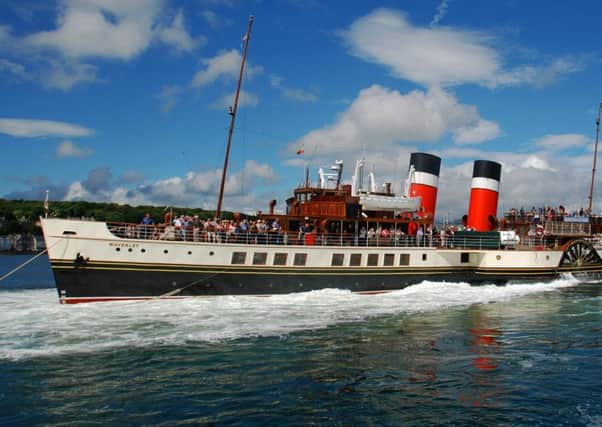Martyn McLaughlin: Why the Waverley paddle steamer must be saved


It is an outlook which only improves during the summer months, and not on account of the erratic west coast weather; the enhancement is provided entirely by the reassuring sight of the Waverley’s raked twin funnels coming into view, as she chugs down past the Tail O’ The Bank.
From a distance, she appears a mere speck in the Clyde’s dull leaden-blue waters, almost insignificant against the grand canvas provided by Tom na h-Airidh and Ben Bowie. Yet all it takes for the roles to be reversed is a simple change of perspective.
Advertisement
Hide AdAdvertisement
Hide AdStepping aboard the Waverley is to enter a world of sensory delights, a world which renders all outside it small and insignificant. Vast piston rods and cranks chatter away in unison, thrumming deep below right up against the soles of your feet. Above deck, a churn of gulls hangs expectantly over a comforting fug of hot oil and cold beer.
She reserves the best, however, for when she is in full flow, as the unrelenting rhythm of her paddles scoop through the sea, an unstoppable force of industrial ingenuity thrashing ever forward through the years. Or so we hoped.
The world’s last seagoing paddle steamer has been a fondly received visitor to communities scattered throughout Scotland’s western waterways for decades. When Caledonian MacBrayne sensed that the days of folk heading “doon the watter” were numbered, they sold her in 1974 for £1 to the Scottish branch of the Paddle Steamer Preservation Society.
No doubt there are some within CalMac who came to regret that decision, but equally, it would be a mistake to mock them for some perceived folly. The Waverley had lost several sailing days the previous two summer season to boiler problems, and the commercial case for her continued service was increasingly difficult to justify.
CalMac, mindful of the ship’s heritage, presumed the society would tend to her in her dotage as a static attraction. Here we are, some 45 years and six million passengers later. The question in 2019 is, having performed one resurrection, can she repeat the trick?
The boiler problems which troubled the grand old lady back then, and sporadically ever since, are now altogether more grave. The inner casings of the vast, oil-filled structures are damaged beyond repair. Their replacement is a process the steamship’s custodians liken to “open heart surgery,” and it will be expensive to boot.
Waverley Steam Navigation Co Ltd, the charity set up to preserve the ship in operating condition, is hoping to raise £2 million so that she can return to service next summer. As Paul Semple, the general manager, concedes, it will be a “significant struggle”.
And yet for all the strain of the annual upkeep costs in the face of rising fuel costs and a stricter regulatory environment, there is undoubtedly a sound economic argument to ensure the Waverley stays afloat for years to come.
Advertisement
Hide AdAdvertisement
Hide AdThe charity points out that the Waverley’s visits throughout Scotland, as well as to England and Wales, generates more than £5.5m for the UK economy each year.
It is an impressive figure, and its real value lies in where the money goes. By virtue of the Waverley’s long-established routes to Scotland’s islands and sea lochs, she and her patrons call at small, rural communities which once thrummed with activity in their Victorian summer heydays.
The Waverley alone cannot turn back the clock and fully restore their lustre, but when she arrives at one their piers teeming with 700 hungry and thirsty punters onboard, it is a cheering sight for local businesses.
Just ask the staff in the Golfers, one of Rothesay’s great wee howffs, who can barely pull pints quickly enough to meet the demand as the tourists come ashore; or those in the bustling Zavaroni’s chippy, just a hop, skip, and stagger away from the boozer — ideal for those Waverley apostles in pursuit of the last fish supper before their beloved steamer sets sail for Glasgow.
Of course, there are some who believe the Waverley’s proud heritage could be preserved without the expense and exertion of rendering her seaworthy once more. Those who envisage her as a floating visitor attraction would do well to look to California, where the Queen Mary has been allowed to fester and decay under the watch of reckless municipal landlords.
But the argument for permanently mooring the Waverley is built on deeper fault lines. It singularly fails to acknowledge how the only reason the ship is still with us at all is due to the hard work of generations of impassioned volunteers who simply refused to countenance the idea that the blast of her steam whistle would fall silent..
We can, and should, rattle some cages to save an icon of Scotland’s maritime heritage, but it is a battle that will be easier won by remembering the Waverley is no museum piece. Her beauty lies in her function. She wears her blood, sweat, and oil with pride.